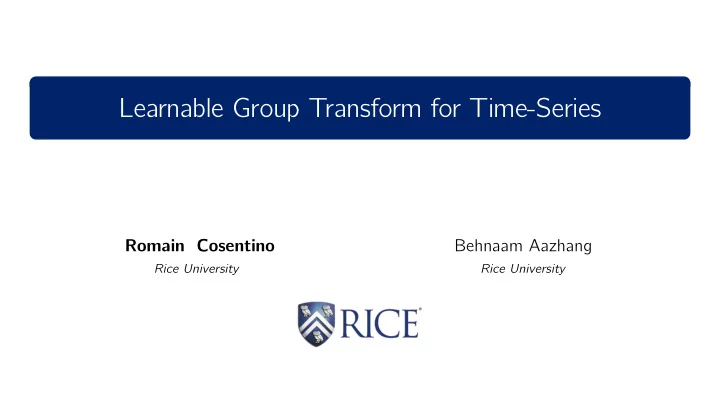

Learnable Group Transform for Time-Series Romain Cosentino Behnaam Aazhang Rice University Rice University
Challenges in Time-Series Example Dataset 1 : Audio field recordings Task: Binary classification Figure: Dimension: 440 , 000 . The red boxes are the locations of the bird song. Several Challenges: High-dimensional signals. Large intra-class variability. A lot of nuisances. 1 http://machine-listening.eecs.qmul.ac.uk/bird-audio-detection-challenge/ 2
Same Challenges Across Domains Various Domains Biodiversity monitoring Speech Recognition Health Care Earth Sciences 3
Common Approach To Overcome These Challenges 1 Project the data in the Time-Frequency plane 2 Use this Time-Frequency representation as the input of a Deep Neural Network We focus on the Time-Frequency Representation 4
Time-Frequency Representation: Example Time-Frequency representations, e.g.: Wavelet transform, Short-time Fourier transform, Deep Scattering Network, Mel Frequency Cepstral Coefficients. Figure: Dimension: 2 , 500 . Intra Cardiac Recording. 5
Intrinsic Problems of Hand-crafted Time-Frequency Representations: Often not aligned with the task: Clustering, Prediction, Classification, ... Require expert knowledge on the data and the task. Require cross-validation of parameters s.a.: number of octaves and wavelets per octave, size of the window,... Such knowledge may not exist. Example: prediction of seismic activity, seizure prediction. We propose a data-driven (end-to-end) approach 6
Building Blocks of Time-Frequency Representations To obtain the Time-Frequency Representation of a signal 1 Build a specific Time-Frequency filter bank. 2 Convolve the filters with the signal. 7
Require Two Components to Create a Filter Bank 1 Select a mother filter ψ . 2 Select a transformation space F . Filter Bank = { ψ ◦ g 1 , . . . , ψ ◦ g K | g 1 , . . . , g K ∈ F} . The g k are samples from the space F . 8
Convolution Between Filters and Signal Equals Time-Frequency Representation Given a signal by s , its Time-Frequency representation is given by Time-Frequency Representation = [ W [ s, ψ ]( g 1 , . ) , . . . , W [ s, ψ ]( g K , . )] T , where W [ s, ψ ]( g, . ) = s ⋆ ( ψ ◦ g ) , ∀ g ∈ F , with ⋆ the convolution operator and ( . ) corresponds to the time axis. 9
Filter Bank Example: Wavelet Filter Bank Mother Filter ψ : Morlet Wavelet Transformation Space F : Linear g ( t ) = t λ We propose to focus on the learnability of the Transformation Space F . 10
Different Transformation Space For the Same Mother Filter Mother Filter STFT Filters Bank Wavelet Filters Bank 11
Transformation Space Induces the Tiling of the Time-Frequency Plane Different Transformation Space ⇒ different Time-Frequency Resolutions. All are constrained by the Heisenberg uncertainty principle. 12
The Space of Continuous and Strictly Increasing Functions A direct generalization of the Transformation Space of Wavelet Filter Bank is given by C 0 g ∈ C 0 ( R ) | g is strictly increasing � � inc ( R ) = , where C 0 ( R ) defines the space of continuous functions defined on R . 13
Recovering well-known filters From C 0 inc ( R ) g ∈ C 0 inc ( R ) ψ ◦ g Affine Wavelet Quadratic Convex Increasing Quadratic Chirplet Quadratic Concave Decreasing Quadratic Chirplet Logarithmic Logarithmic Chirplet Exponential Exponential Chirplet 14
Sampling and Learning g ∈ C 0 inc ( R ) 1 Sampling: Strictly Increasing Piecewise Continuous Functions can be re-written as a 1 -layer ReLU Neural Network. 2 Learning: Given a set of signals { s i } N i =1 , a mother Filter ψ , a Deep Neural Network F designed for a specific task represented by the loss L , N � � � min F ( W [ s i , ψ ]( g Θ , . )) L , Θ i =1 where Θ are the parameters of the 1 -layer ReLU Neural Network. 15
Learnable Group Transform: Framework 1 Sample g θ k From 1-Layer ReLU NN. 2 Compose the Mother Wavelet ψ with g θ k . 3 Convolve ψ ◦ g θ k with signal s i . 16
Experiments Evaluation of our method on three datasets: 1 Artificial Data: Increasing Chirp VS Decreasing Chirp. 2 Haptics Data: Small dataset where the optimal Time-Frequency Representation is unknown. 3 Bird Song Classification: Large Scale dataset where the optimal Time-Frequency Representation is known. We obtain results at the level of state of the art methods. 17
Learnable Group Transform Filters - Filter Analysis Samples of Learned Filters For Bird Song Dataset Classification Task: Samples of Learned Filters For Haptics Dataset Classification Task: 18
Conclusion We propose an end-to-end approach to filter bank learning. Our approach generalize Wavelet Transform by proposing a non-linear strictly increasing transformation function as opposed to the linear one. Competes with state of the art methods in different applications. Recover optimal filters for Bird Song classification task. 19
Recommend
More recommend